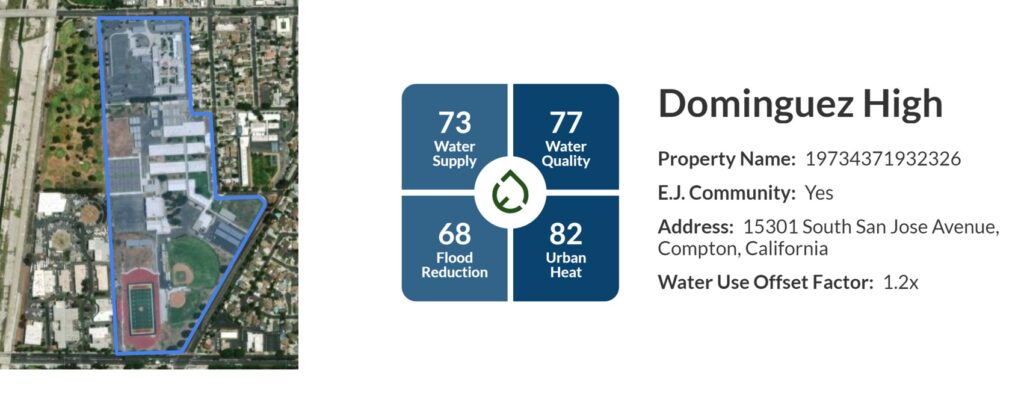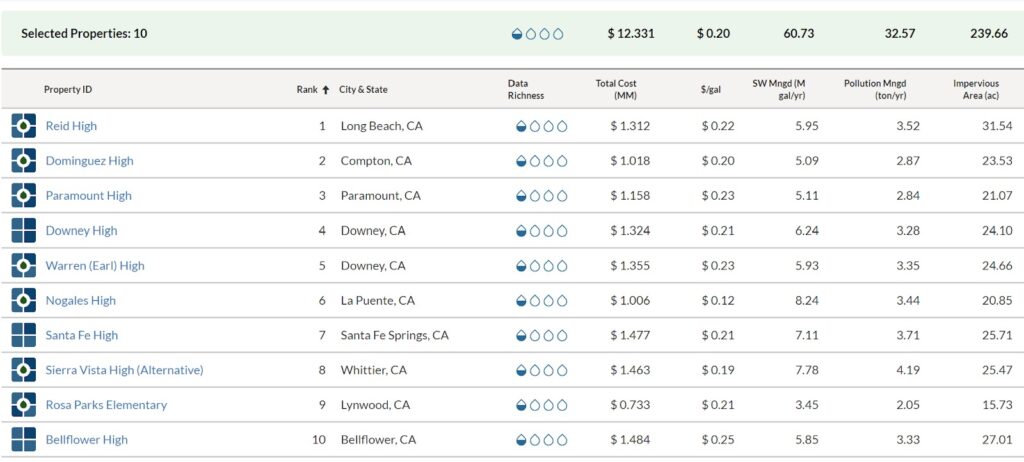Authors: Shannon Spurlock, Sonali Abraham, and Morgan Shimabuku from the Pacific Institute, and Nicole Beck from 2NDNATURE
Recently, Los Angeles has encountered significant challenges in water management and urban runoff, highlighting the urgent need for innovative solutions.At the same time L.A. County is projected to encounter significant financial challenges related to climate change, with estimated costs reaching $4.5 billion to address urban runoff through the year 2040, according to a report by the Los Angeles Times. A new analysis delves into the potential for managing urban stormwater runoff through transforming school campuses across LA County into vibrant, sustainable green spaces. This work aims to demonstrate how schools can play a role in significantly mitigating urban runoff issues and enhancing water quality. By converting educational settings into environmentally resilient areas, students and the surrounding communities have easier, neighborhood-based access to healthier, more sustainable environments.
The Role of Urban Stormwater Runoff in Climate Adaptation
An uncertain climate future poses risks on a global scale, impacting public health, economies, and ecosystems. In California, severe droughts and intense storms have led to water scarcity, wildfires, flash floods, and water pollution. Urban areas, marked by vast expanses of asphalt and concrete, exacerbate these issues by spurring urban stormwater runoff, a leading source of water pollution.
Adapting to and mitigating the negative impacts of climate change presents an opportunity to harness stormwater as a valuable resource. Stormwater can enhance community vitality, supporting sustainable growth and climate resilience. Implementing nature-based solutions to capture and reuse stormwater can create additional water supply, reduce flooding, and improve water quality. These strategies also help reduce urban heat islands, sequester carbon, improve air quality, and enhance community livability while reducing the consumption of potable freshwater.
Golden Opportunities in California
Recent scientific studies by 2NDNATURE reveal a fascinating opportunity: California’s urban areas see over 2.0 million acre-feet of stormwater annually. Astonishingly, 52% of this—equivalent to 350 billion gallons a year—falls directly on areas with underground water supply basins. By just tweaking our urban landscapes a bit, we could channel a massive volume of water back into the earth, recharging our precious freshwater aquifers. Putting more of this water underground also helps to purify it and keep pollution from entering our streams and ocean, helping to protect and restore California’s famous coastline for beachgoers, surfers, and the tourism industry.
Funding Multi-Benefit Community Investment in Los Angeles
The Los Angeles area typically receives about 14 inches of rainfall annually. Investing in a new multi-benefit approach, stormwater management projects could protect communities from flooding, reduce pollution, and contribute to the local water supply needs. The stormwater parcel tax approved by Los Angeles voters (Measure W) in 2018 generates nearly $300 million annually, providing funding for new stormwater projects. Learn more about how these funds are and can be used from the LA County Safe Clean Water Program website.
Pacific Institute: Reimagining Water for Changing World
The Pacific Institute, a non-profit research organization founded in 1987, combines science-based thought leadership with active outreach to develop sustainable water policies. We focus on catalyzing water resilience through three key areas: water and climate equity, water efficiency and reuse, and nature-based solutions. A recent project, “Advancing Stormwater Capture for Greener Schools in Los Angeles,” aims to accelerate the greening of schools in Los Angeles County by advancing stormwater strategies and elevating projects that provide community benefits, benefiting students, communities, and school sites.
The Project: Greening Los Angeles County Schools
Los Angeles County, the most populous county in the United States, is home to approximately 1.3 million public school K-12 students in 80 districts. These students attend school on 1,300 campuses dotted across the county. LA County schools have significant amounts of paved area and experience intensely hot temperatures, with reports of asphalt reaching 140 degrees Fahrenheit and rubber surfaces reaching 165 degrees Fahrenheit. When nature-based stormwater management solutions are implemented at schools, they can add much-needed green space, lower playground temperatures, and help reduce neighborhood flooding. In places where schoolyards serve as a valuable, shared community space, these benefits can extend beyond the students to the surrounding community.

Despite the potential benefits, schools have struggled significantly to secure funding through the Measure W initiative (i.e. LA County Safe Clean Water Program). A recent evaluation by Los Angeles Waterkeeper (2023) indicates that despite over $1 billion being allocated for stormwater projects under the Safe Clean Water Program, only a minor fraction has been directed towards green schoolyard projects. The report stresses the need for the Safe Clean Water Program to develop a clearer strategic focus by incorporating more robust evaluation metrics and prioritization criteria that specifically highlight the benefits of green schoolyards.
Rethink Runoff on School Campuses
By implementing solutions to better manage stormwater runoff, school campuses can be transformed into green, sustainable spaces that can reduce local flood hazards, reduce peak playground and school temperatures, and enhance water quality. Green infrastructure can be designed in ways to achieve multiple goals, bringing benefits to the students, staff, and surrounding community. Here are specific examples of green infrastructure that can be implemented:
- Rain Gardens: These shallow, vegetated basins collect and absorb runoff from rooftops, sidewalks, and streets. These structures help reduce flooding, filter pollutants, and recharge groundwater.
- Bioswales: Similar to rain gardens, bioswales are linear, vegetated channels designed to slow, collect, and filter stormwater. They can be installed along the edges of parking lots and driveways to manage runoff.
- Green Roofs: Covering rooftops with vegetation reduces runoff, improves insulation, and lowers urban heat island effects. Green roofs also provide habitat for wildlife and create green spaces in urban areas.
- Cisterns and Rain Barrels: These systems capture and store rainwater from roofs for later use in irrigation and other non-potable applications, reducing the demand for municipal water supplies.
- Permeable Pavement: These materials allow water to pass through, reducing runoff and promoting groundwater recharge. Permeable pavement can be used in parking lots, walkways, and playgrounds.
- Drought Tolerant Landscaping: Using native and drought tolerant plants reduces the need for irrigation, conserves water, and creates resilient landscapes that can withstand changing climate conditions.
- Tree Planting: Planting trees throughout school campuses provides shade, reduces runoff, improves air quality, and enhances the aesthetic appeal of the area. Trees also help mitigate the urban heat island effect.
- Educational Signage: Installing signs that explain the benefits of green infrastructure and stormwater management practices educates students and the community, encouraging them to adopt similar practices at home.
As climate change intensifies, communities must fundamentally transform their urban management strategies. By investing in stormwater solutions in schools, we directly engage and inspire the next generation, equipping them to rethink runoff and prepare to tackle the immense water challenges ahead. This approach not only revitalizes educational environments and uplifts the surrounding community, but it also empowers students to be proactive stewards of our urban landscapes.
Uncovering and Exploring the Opportunities
The Pacific Institute partnered with 2NDNATURE to utilize their GIS-based platform, Rainsteward™, specifically designed to help large landowners quantify the value and impact of their rain and runoff investments.
The process was simple and began with uploading a publicly available GIS database of LA County school campus boundaries into Rainsteward. Rainsteward’s analytics then took over, automatically profiling each campus using 2NDNATURE’s peer-reviewed scientific methodologies. This provided an array of property-specific information and data. The initial values are drawn from the best available datasets, with the ability of users to refine the accuracy over time as projects move through planning, design, construction, and implementation.
Key Data Generated by Rainsteward
- Numeric Benefit Badge: Rainsteward generates a numeric benefit badge for each campus, summarizing the relative benefits to the property and surrounding areas if targeted for stormwater improvements.

- Water Footprint: The water footprint includes estimated annual consumptive water use, stormwater runoff, and pollution levels, providing a comprehensive overview of each campus’s water impact.
- Geographic Information: Essential data needed by landscape architects or engineers conducting feasibility analyses and concept plans for the campus is generated, aiding in effective planning and design.
Critical Insights and Summarized Data
At the campus-specific scale, Rainsteward provides critical insights and data for property owners, planners, engineers, and funders—information that typically takes weeks or months to compile from various sources. A summary portfolio of this campus-specific data highlights:
- Water Consumption and Runoff: LA County schools collectively consume an estimated 2.5 billion gallons of potable water and manage an average of 3.1 billion gallons of runoff per year.
- Runoff Utilization: The findings indicate that there may be large potential to better utilize urban runoff on school campuses. This assessment using Rainsteward shows that average runoff exceeds estimated consumption by over 1.3 times.
- Pollution Generation: LA County Schools collectively generate over 1,531 tons per year, that could be reduced as a result of better managing campus stormwater runoff.
This project showcases Rainsteward’s ability to integrate and analyze this data aiding large-scale property owners in decision-making and highlighting the potential for innovative stormwater solutions to help create healthier, more sustainable communities.
Prioritizing Impactful Projects
Rainsteward’s functionality supports the prioritization of school campuses for stormwater strategy implementation based on different weightings of the four key benefits. This capability is useful, helping stakeholders with different goals and needs to coalesce around a plan for implementing stormwater capture strategies on their properties.

For the project, Rainsteward identified the top 10 LA County School campuses for achieving the four goals of water supply, flood reduction, water quality improvement, and urban heat reduction. It also showed the potential collective impact and estimated funding needed to deliver community uplift across the portfolio of public school campuses in LA. For these 10 properties, an estimated $12M investment could better manage over 60 million gallons per year of rain and runoff, which is more than 1.3 times the amount these ten school campuses are estimated to consume each year. Better management of this runoff would also eliminate over 32 tons of stormwater pollution annually.
Next Steps for LA County Schools
The Regional Oversight Committee (ROC) evaluates funding priorities and if Safe Clean Water Program (SCWP) goals are being achieved. Our project demonstrates how a decision support tool like Rainsteward, when complemented with insights from the school and surrounding community, can help evaluate campus suitability for stormwater opportunities, providing key information to assess project feasibility and submit competitive and compelling funding requests for investments on school campuses. Rainsteward insights are flexible and can rank campus recommendations based on the priorities of a region, school district, specific campus, or funder.
The Value of Rainsteward™
Rainsteward brings technical information to the community and the general public in a format that is easily understood and distilled. The tool provides scientifically credible information in an accessible and interactive format, allowing stakeholders to understand the value – and opportunity – of stormwater management and leverage it on their property. In this project, Rainsteward allowed the Pacific Institute team to understand the volumetric potential of stormwater capture on school campuses and clearly delineate the co-benefits this strategy can provide.
Conclusion
Tools like Rainsteward are essential in transforming how we view and manage stormwater by using data and sound science to expose multi benefit opportunities. By leveraging advanced GIS technology and comprehensive data analysis, Rainsteward can empower schools, communities, and policymakers to make informed decisions that enhance resilience and sustainability. As LA County continues to face the challenges of climate change, innovative solutions like Rainsteward will play a crucial role in shaping a better future for all.
Call to Action: Community Engagement
Preliminary findings with Rainsteward are encouraging and show significant potential for transforming and optimizing stormwater management in LA schools. Now, it’s up to policymakers, elected officials, and urban planners to take the next steps.


